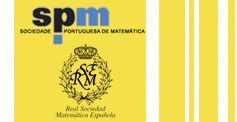
Ignacio García-Marco (Universidad de la Laguna)


An algorithm for checking whether a simplicial toric ideal is a complete intersection
Let kbe an arbitrary field and k[x] = k[x1, … ,xn] and k[t] = k[t1, …, tm] two polynomial rings over k. Let A = {a1, …, an} be a set of nonzero vectors in Nm; each
vector ai = (ai1, ... , aim) corresponds to a
monomial tai = tai1 …taim m in k[t]. The kernel of the
homomorphism of k-algebras f: k [x] ->k[t]; xi -> tai is called a toric ideal and will be denoted by IA. It is an A-homogeneous
binomial ideal, i.e., if one sets the A-degree
of a monomial xa Îk[x] as a1a1 + …+anan ÎNm,
and says that a polynomial fÎk [x] is A-homogeneous if its monomials
have the same A-degree, then IA is generated by A-homogeneous binomials.
The ideal IA is a complete intersection if there exists a system of A-homogeneous binomials g1,…, gs such that IA= (g1,…, gs) , where s = n– rk (ZA).
If n> m and A = {d1e1,…, dmem; am+1,…, an}, where {e1,
…, em} is the canonical
basis of Zm, the toric
ideal IA is said to be a simplicial toric ideal.
The purpose of this work is to provide and
implement an algorithm for determining whether a simplicial toric ideal IA is a complete intersection without having
to compute a minimal system of A-homogeneous
generators of IA. This is a
joint work with Isabel Bermejo.



